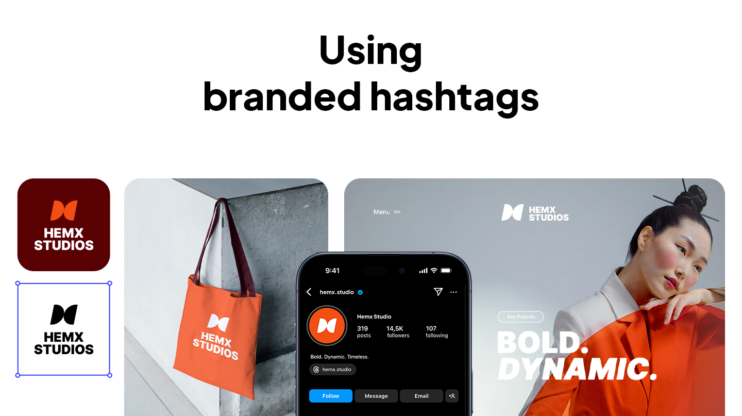People don’t just want brand promises anymore. They want receipts. Edelman’s 2024 Trust Barometer says 80% of people expect companies to actually help fix social problems, not just move products.
Yet, trying to incorporate sustainability into brand can feel like a no-win situation. Say nothing, and you look careless. Say too much without the receipts, and people will call you out for faking it. This guide is here to help you walk that line by starting with what you do, not what you say. Action first, then words.
Before we get into how to bring these values into your brand, let’s just be clear on what we’re even talking about:
- ESG is the things that show up in how your business runs, like your environmental footprint, how you treat workers, how decisions are made.
- DEI is about who’s in the room, who’s being listened to, and whether your team and messaging reflect the people you say you care about.
- Sustainability is what you do to reduce harm: less waste, better materials, smarter use of energy, and more long-term thinking.
They’re not the same thing, but they overlap, and more often than not, people will judge your brand based on how seriously you take them. Now, let’s jump into our 3-step action plan to incorporate sustainability into your brand.
1. Incorporate sustainability into brand operations first
When you’re building a brand on ESG or DEI values but your actual business doesn’t back them up, you’re walking into a minefield. Customers today can spot the disconnect between what you say and what you do, and when they find it? They’re not shy about calling you out. You wouldn’t advertise a five-star hotel experience if half your rooms had broken air conditioning. The same principle applies here.
Besides avoiding unnecessary backlash, this is also a good business opportunity for you. According to a joint study by IBM and NRF, 72% of Gen Z and Millennials will switch brands when they find one that better matches their values. When you get your operations aligned with your stated values, customers stick around longer, refer more people, and pay premium prices. That’s the real business case for authenticity: it makes your customers more valuable and harder to steal.
What parts of your business should reflect your values first?
You don’t need to fix everything at once, but you do need to fix the right things first. Start where these three factors intersect:
- Customer sensitivity (What do your customers actually care about?)
- Internal readiness (What can you change without a 12-month operations overhaul?)
- Public visibility (What sends the strongest signal that this isn’t just talk?)
That’s your ESG brand entry point. Start with one part of your business where your values, customer expectations, and public visibility meet, and get that part right before scaling the message.
At 10Web, we knew that offering tools to help others build eco-conscious brands, like our sustainability-focused branding kit, would mean very little if our own operations didn’t reflect those same values. So, we made sustainability part of our infrastructure too.
That’s why we chose Google Cloud Servicers as our hosting partner. Their long-term goal of running on 24/7 carbon-free energy aligned with what we wanted 10Web to stand for.
That’s the real lesson: start where it matters most. Then layer in the message. If you skip the first part, no brand kit in the world can help you earn trust.
Here are some common areas for ESG and DEI you could potentially focus on:
| Area | What That Actually Looks Like |
| How you treat people | Be upfront about pay, don’t make people dig for it. Skip unnecessary degree requirements and hire for skill. Give people room to work how they work best, and if your company’s doing well, give back to the community you’re in. |
| What you make | Make stuff that doesn’t fall apart in a year. Let people fix things instead of replacing them. Use packaging that won’t last longer than the product, and stop chasing trends, build something that holds up. |
| Your whole process | Use materials that don’t trash the planet. If you can, make things closer to where they’ll be sold. And think about what happens when someone’s done with your product, can it be reused? Refilled? Recycled? If not, you’ve got work to do. |
| Who you work with | Work with suppliers who care. Be clear about what you expect from them, how they treat people, how they handle materials. And check in, often. This stuff can’t run on autopilot. |
What if you’re just starting out and don’t have much to show yet?
Start by saying that, clearly. In our next steps, we’ll explore how to communicate it in more detail, but you should just keep the principle in mind: consumers are more likely to trust a brand that admits it’s just starting out than one that fakes maturity it doesn’t have.
Incorporate sustainability into brand and document your progress. Launch one internal initiative and one external goal, and be radically honest about what you’re working on.
2. Show your values through design, messaging, and behavior
Once you’ve taken real action, your brand needs to show it: visually, verbally, and behaviorally. If customers can’t see your values in how your brand looks and sounds, they won’t believe they’re real.
A lot of companies launch a great initiative but struggle to translate it into something meaningful. Here’s how 10Web Co-founder and CEO Arto Minasyan put it:
At 10Web, we saw that gap and built a free branding kit to help close it. It’s a toolset designed specifically for founders and small teams who want to build brands rooted in values like sustainability, but don’t have a design agency on speed dial. The kit includes:
- An AI-powered Logo Maker that helps you create professional designs in minutes.
- A Mission and Vision Statement Generator to clarify what you stand for.
- A Slogan Generator that keeps things punchy but meaningful.
- An Industry Explorer to position your message clearly in your niche.
All those tools help build alignment between what you do and how you show up. When sustainability is already part of your operations, as I already mentioned, this kit gives you a starting point to show that you work honestly and effectively.
For example, if your brand is focused on reducing packaging waste, the kit helps you develop clear language and visual consistency around that effort. If your mission involves ethical labor or local sourcing, the tools help translate that into a message your audience can trust.
So don’t skip this step. If you’ve already done the hard part, making your business better. Use tools that help your brand reflect your work with clarity and credibility.
According to McKinsey, willingness to pay more for even sustainably packaged goods has risen by 20% since 2020. So, if your prospect knows about your sustainability, their readiness to pay more is more likely.
How do you turn your values into branding people can see?
You might come up with clever slogans to share with people, but stop before you do it. Reflecting your values is beyond slogans. It means designing a brand experience that aligns with what you stand for. You can start with three simple areas:
- Design and imagery: If you talk about sustainability, your packaging and visual design should reflect that: minimalist, recyclable, or reusable.
- Tone and language: Strip out vague phrases like “doing good” or “committed to change.” Use specific, concrete claims:
“We eliminated virgin plastic in 85% of our packaging by Q2 2024”
“50% of our new hires in 2023 came from underrepresented backgrounds” - Brand behavior: Do your partnerships align with your values? Are your ambassadors, social media interactions, and hiring pages walking the same talk?
There are brands that you can borrow ideas from. Take Allbirds. They print each product’s carbon footprint directly on the shoe and design its entire experience around simplicity and climate transparency. It’s consistent because the values are embedded across product, design, and messaging.
Another example is Sephora’s DEI messaging. It includes real hiring stats, diverse representation across channels, and supplier transparency.It works because it’s not a campaign, it’s a brand operating principle.
What if we have multiple values, how do we express all of them clearly?
You don’t need to show everything your company believes in. If you try to express ten values at once, your message will get diluted, and your audience will get confused.
Instead, focus on the two or three values that matter most to your stakeholders. That could mean your employees, your customers, your local community, or your investors, depending on your business model and stage.
You’ve done the work. Now build the brand that shows it!
Try the Free Branding Kit from 10Web!
3. Communicate without greenwashing or performative DEI
Once your operations and brand identity are aligned with your values, the final step is to talk about it, but do it carefully. This is where you can “accidentally” lose credibility. Consumers are increasingly skeptical of vague claims and polished campaigns that lack substance.
Performative DEI or greenwashing doesn’t just hurt your image, it creates long-term distrust. According to KPMG’s survey, 50% of consumers say they would boycott brands that mislead them about ESG efforts. So, it’s important to stay authentic and incorporate sustainability into brand with honest steps.
How do you talk about your brand sustainability without sounding fake?
The answer is progress over perfection. When everything’s presented as perfect, especially when companies try to incorporate sustainability into a brand, the customers can sense it. Instead, share real results, and here’s how:
| What to Do | Why It Matters | Example |
| Use real data | Specificity builds credibility | “We reduced packaging waste by 20% last year,” not “We care about the planet” |
| Back it up with proof | Names, numbers, and third-party links show accountability | Mention your audit partner, certification, or NGO |
| Acknowledge gaps | Shows honesty and direction, not just polish | “We’ve launched inclusive hiring training. Next, we’re reworking supplier standards.” |
| Be consistent across channels | People will compare your claims to your actions, especially on social and careers pages | Align messaging on site, LinkedIn, and job listings |
What if you’re still figuring things out and don’t feel “ready” to share?
As I already mentioned, today’s audience values honest work in progress over radio silence or over-polished narratives. Let your audience know that you’re in the process of review, or that you’ll be focusing on specific ESG and DEI work for a specific time period, and keep them updated.
Edelman’s 2023 Trust Barometer found that 76% of people trust brands more when they admit their shortcomings. So, just lead with integrity. By documenting your journey, not just your outcomes, you build trust and signal accountability.
Conclusion
If you care about things like sustainability or equity, your brand should show it, but only after your business does. Start by fixing what matters most to the people who matter to you. That might be your team. Your customers. The community you operate in. Start there.
When you’re ready to share? Be real. A single honest sentence is more powerful than a polished campaign. 76% of people say they trust brands more when they admit what they’re still working on. Use that. Don’t try to look perfect. Just show the work.
FAQ to help you incorporate sustainability into brand
How do you make a brand sustainable? Why is sustainability important in branding? How do you incorporate sustainability into your designs?
You’ve done the work. Now build the brand that shows it!
Try the Free Branding Kit from 10Web!







